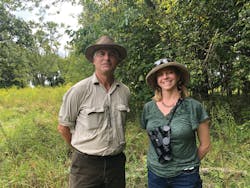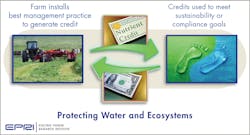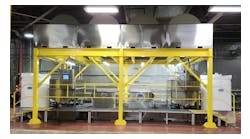Working to improve water quality in the Ohio River Basin through credit trading
By Jessica Fox
The Ohio River Basin Water Quality Trading project is the world’s largest water quality credit program. The nearly 50-year-old nonprofit research organization, the Electric Power Research Institute (EPRI), led the development of the program along with a collaboration of companies, farmers, state and federal agencies, and environmental group input. Focused on environmental impacts from diverse sources, the project facilitates broad industrial and agricultural collaborations to achieve a common commitment to improving water quality as well as broader environmental indicators. In addition to the water quality improvements, the effort qualitatively tracks ancillary social and ecological benefits such as habitat conservation, pollinator and rare species protection, farm animal health, and farmer wellbeing.
Working with local farmers and private landowners in Ohio, Indiana, and Kentucky, the project funds conservation practices that reduce pollution to U.S. waterways and protect ecosystems. The credits protect local water quality and tackle the primary pollutants causing the Gulf of Mexico hypoxia zone, one of the largest ocean dead zones in the world. On May 29, 2019, EPRI announced that it will move credits from the project to international credit trading markets. This is a unique collaboration between a water quality project and an environmental asset credit broker to provide access to some of the world’s largest environmental credit buyers.
The credit program is backed by watershed modeling, on-the-ground project verification, and rigorous credit registration with Markit Environmental Registry. Each credit comes with unique serial numbers, on-farm photos, and full verification documentation signed by state agencies so that anyone can track and confirm every conservation practice, every pound of pollution reduction, and every credit.
What Is a Water Quality Credit?
A water quality credit is a quantified and verified representation of a pollutant reduction within a water system. Each credit equals one pound of nutrient (nitrogen or phosphorus) reduction, plus associated ancillary qualitative ecological and social benefits. A thorough and transparent process ensures that credits represent real environmental improvements verified by state agricultural and permitting agencies.
Based on availability, credits can be purchased from specific counties within the Ohio River Basin and can estimate the value of their credits at any downstream location using the project’s sophisticated watershed modeling. Credits also can be purchased as a “bundle” of benefits that include the nitrogen and phosphorus reductions as well as any associated ancillary qualitative ecosystem benefits, such as the protection of pollinators and rare species, greenhouse gas reductions, and animal health.
In 2015, the U.S. Water Alliance awarded EPRI’s Ohio River Basin Water Quality Trading Project the United States Water Prize. The prize honors individuals, institutions, and organizations that have made an outstanding achievement in the advancement of sustainable solutions to national water challenges.
How Are Credits Generated?
Credits are created through the installation of conservation practices with private landowners in Ohio, Indiana, and Kentucky. Nearly all the landowners are small family farmers producing corn, soy, wheat, beef, and milk. Projects are intended to improve water quality while maintaining crop yields for farmers. Typical practices include cover crops, reduced fertilizer application, riparian buffer strips, cattle exclusion fencing to prevent erosion of natural waterways, milk house waste management systems, manure wetland treatment systems, and cattle heavy use areas that allow for effective manure storage and management. Projects that involve the planting of forests also are included. Contracts with farmers range from five years for seasonal practices (i.e., cover crops) to 40 years for forest planting.
Credit Registry and Tracking
A credit registry is a tracking system that follows a credit from creation to sale and ultimately to retirement. Markit Environmental Registry runs the Ohio River Basin water quality project credit registry and ensures that each credit is created and used precisely as approved under the project’s trading plan. The online registry provides security measures similar to online banking and provides transparency to the market. In one online location, information about each farm project is captured; agriculture agencies “verify” that best management practices have been implemented on the ground; permitting authorities “certify” that a credit is acceptable for regulatory compliance; credit buyers can search for credits available to purchase; and stakeholders can view public information on projects.
The registry uses the WARMF watershed model to calculate specific values for each credit when buyers are interested in understanding the load reductions of their credits at specific sites located significantly downstream from the location where the original credit was generated. The registry assigns a unique serial number for each pound of nutrient reduction and allows for the tracking of the credit through its lifecycle. The registry is a key component of the project and ensures the same process and protocols are applied across the large project area and between multiple states (Ohio, Indiana, and Kentucky).
How Many Credits Do I Need?
Impacts to water quality come from many types of operations, including milk, corn, soy, beef, bourbon, beer, and numerous other food production and consumption activities. Credit purchases will depend on the need to manage full corporate impact within the Ohio River Basin, label products as sustainable, offset personal footprints, meet permit discharge limits, or meet United Nations Sustainable Development Goal targets and similar sustainability reporting standards. The typical nitrogen footprint per person in the United States from food alone is 28 kg/yr, or about 60 credits per year.
Working with farmers, the water quality credits help to protect watersheds that support agriculture operations by providing a science-based option for those seeking to comply with National Pollutant Discharge Permit limits, resolve supplemental environmental project (SEP) obligations, mitigate supply chain impacts, and even meet personal and corporate environmental footprint goals. Indiana, Ohio, Kentucky, the U.S. Department of Agriculture, and the U.S. Environmental Protection Agency (U.S. EPA) are among the supporters of the project. To date the project has generated 100,000 verified water quality credits from agricultural conservation practices on farms in the Ohio River basin.
In February, U.S. EPA affirmed its support and encouragement for using water quality trading to improve water and reduce excessive nutrient loading. Details are included in its Water Quality Trading Policy Memorandum. EPRI has conducted research on environmental markets for more than a decade and initiated the Ohio River Basin Water Quality Trading Project in 2009 to test the viability of market-based approaches for achieving water quality goals through nutrient reduction. This effort, the world’s largest water quality trading project, can serve as a model for how government, industry, farmers, and environmental organizations can work together to protect water and ecosystems.
To learn more about the Ohio River Basin Water Quality Trading Project, visit http://wqt.epri.com. IWW
About the Author: Jessica Fox is senior technical executive at the Electric Power Research Institute, where she executes complex initiatives that protect ecosystems, reduce corporate risk, and resolve barriers to multi-stakeholder collaborations. She is a trained Master Facilitator and conflict resolution mediator, a member of the United States Ecological Society of America, and a Certified Habitat Steward by the National Wildlife Federation. She has a B.S. from University of California at Davis, and an M.S. from Stanford University.




